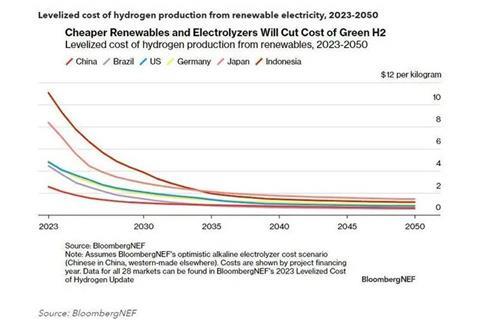BloombergNEF (BNEF) the specialist new energy research division of Bloomberg, has unveiled forecast data for the global energy landscape which indicates green hydrogen, produced from renewable energy sources, will be cheaper than fossil gas hydrogen in key markets by 2030.

A recent report from BloombergNEF (BNEF) indicates green Hydrogen, produced using renewable energy sources, is on track to become cheaper than grey hydrogen, derived from gas, in several key markets by 2030.
The hydrogen production spectrum includes blue hydrogen, produced from gas with carbon capture and storage, and grey hydrogen, created using gas or methane through steam methane reformation without capturing greenhouse gases emitted during the process. Green hydrogen, on the other hand, is made exclusively from 100% renewable resources such as solar and wind energy, resulting in zero emissions.
However, BNEF notes that global inflation and higher financing costs have led to an increase in the levelised cost of hydrogen in 2023. As a consequence, blue hydrogen currently remains the most cost-effective low-carbon option for producers, benefiting from the recent drop in gas prices. But this trend is expected to shift significantly in the coming years. According to the BNEF report, new renewable hydrogen projects are projected to surpass the cost-efficiency of existing grey hydrogen facilities in five critical markets - Brazil, China, Sweden, Spain, and India - by 2030. By 2035, new green hydrogen will be more cost effective than grey hydrogen in over 90% of markets.
While blue hydrogen currently holds the advantage, BNEF anticipates green hydrogen will bridge the gap, surpassing blue hydrogen in all modelled markets one to three years earlier. In specific scenarios, green hydrogen could become cheaper than new blue hydrogen as early as 2028 using Chinese alkaline electrolysers, and by 2033 using western alkaline electrolysers.


















